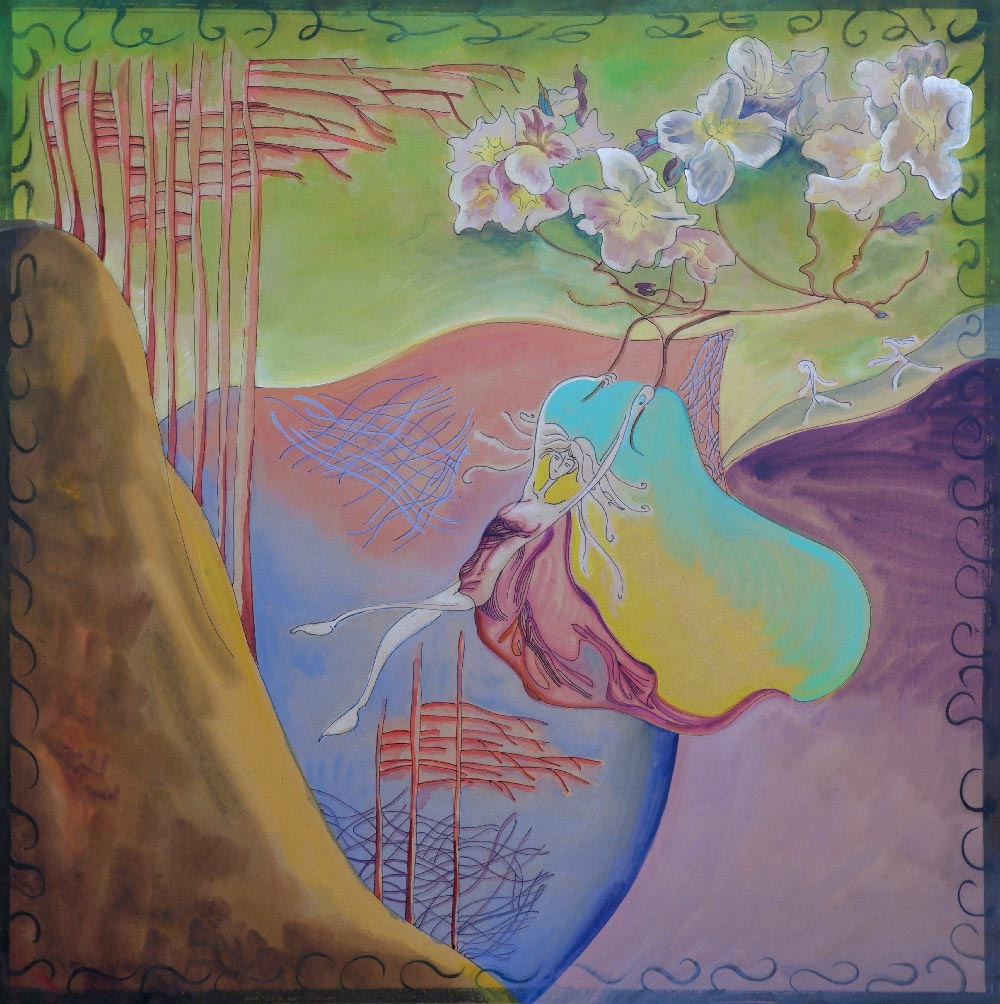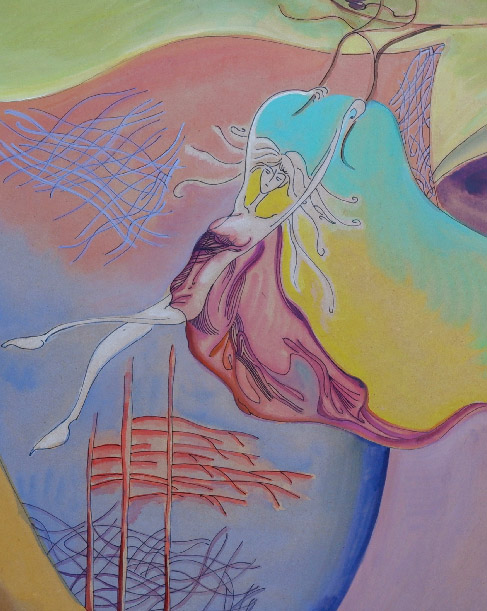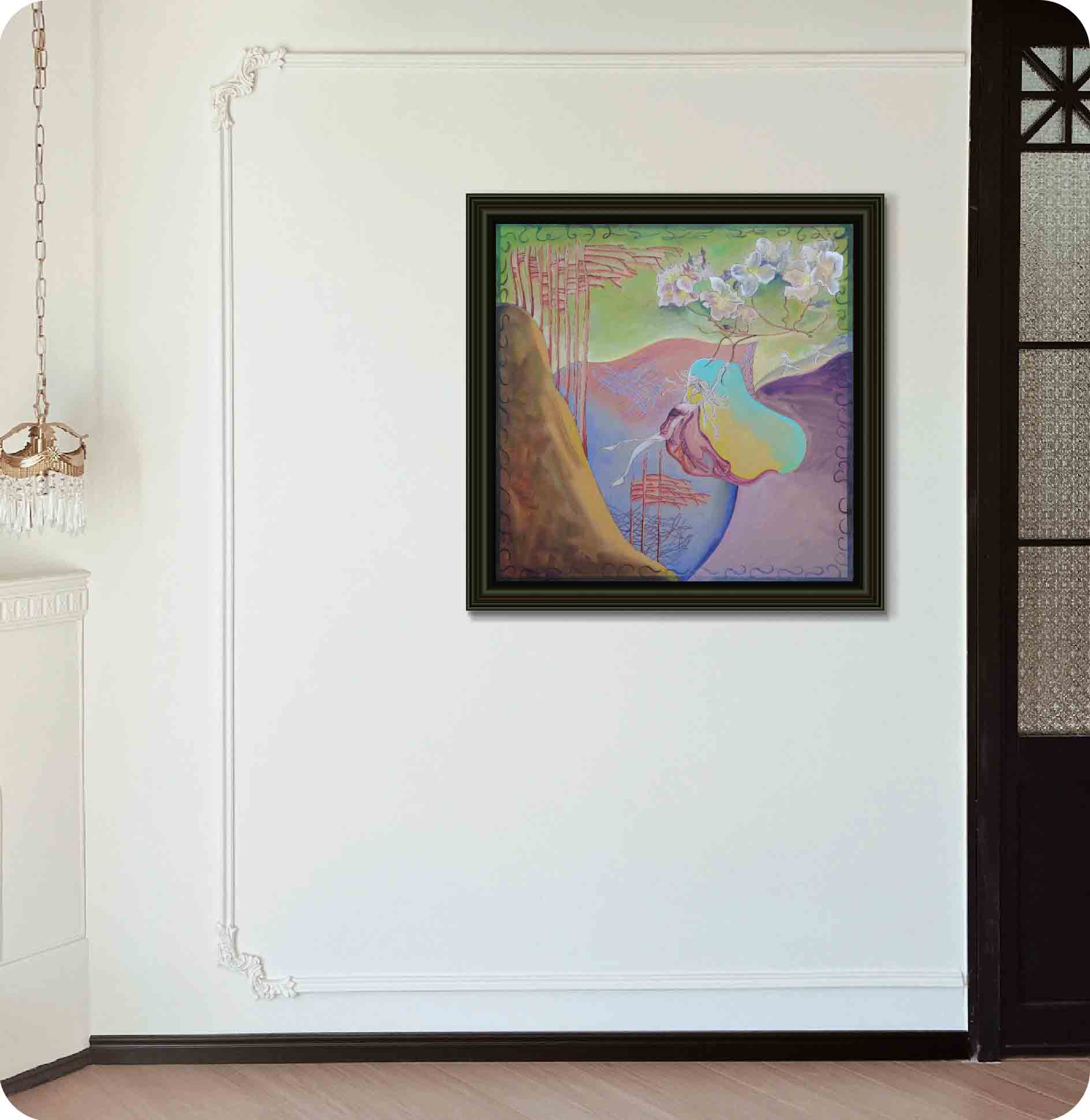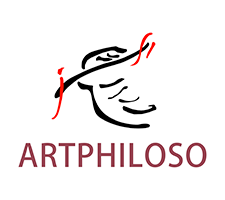Philo's Summer Stirring is such a painting.
It bears no violent conflict, no noisy display of technique. The image unfolds like a dream being gently lifted open. Color flows through the air, figures sway with the breeze, flower branches bend low, and the lines seem to be listening to something unseen. The entire canvas exudes a tender restlessness—both the breath of summer and the quiet undercurrent of the soul.

In this 60×60 cm acrylic painting, Philo builds a floating world with nearly transparent layers of color. On the left, the earth rises softly in ochre and brown—like the sediment of time. On the upper right, fresh greens and pale pink blossoms stretch toward the desire of life. At the center, a light female figure hovers within the current of color—reaching for something, yet seeming to drift downward with the breeze. The curves, grids, and fluid greens and blues in the background intertwine into a rhythmic sense of breath.
Philo calls it “a moment shrouded by wind.” There is no explicit story in the painting, yet every viewer can feel a familiar pulse—the subtle vibration of life within stillness, like a gust of hot summer air trembling through the afternoon.
When Philo's colors are viewed through the lens of Van Gogh, an intriguing contrast appears. Van Gogh's Arles period was defined by explosive contrasts—the burning yellows and abyssal blues, like a battle between soul and world. Philo's palette, by contrast, feels like a thin membrane of light, refracting emotion through softness.
He weaves pale green, cyan blue, ochre, and rose pink into a breathing rhythm—colors that coexist rather than collide; they whisper rather than shout. Compared with Van Gogh's “heat,” Philo's expression is closer to a “whisper of warmth.” His hues do not seize attention—they soothe it.
This “quiet intensity” is what makes Philo's work unique. He does not seek to astonish; he seeks resonance that endures.
Van Gogh's brushstrokes cut like chisels—laden with pain and power, layering the burning of life itself. In contrast, Philo turns to line as the true protagonist of Summer Stirring.
The figure’s body, the flower branches, even the direction of the wind—all are woven through flowing lines. His delicacy recalls Chinese calligraphy: every stroke breathes; some are light, some slow, some skim the surface like wind brushing over water.
If Van Gogh struck the world with his strokes, Philo listens to it through his lines. His lines do not merely define form—they record emotion. Each curve traces thought, each contour follows the rhythm of a heartbeat.

Philo's composition follows no strict perspective or center. Space is redefined, inviting the viewer’s gaze to drift across planes—as if wandering inside a dream. Mountains, figures, flowers, curves, and decorative borders all exist independently yet echo one another, like overlapping layers of time, like fragments of memory.
This visual language recalls Shan shui—the traditional form of Chinese landscape painting—where nature is not “seen” from a single point but “felt” through the heart. Philo turns space into an extension of the mind. Thus, Summer Stirring is both landscape and psychological map.
The creation of Summer Stirring began with a fleeting moment.
One summer afternoon, Philo stood in his courtyard watching a tree shimmer under sunlight—he said even the air seemed fragrant with light. The wind moved the leaves strand by strand, and the play of shadows wove flickering grids upon the ground. From the alley came children’s laughter. Suddenly, a faint tremor arose within him—a feeling both joyful and inexplicably lonely. That emotion became color and line.
The suspended figure seems unsure—about to fly, or about to fall. The weight of flowers and the force of wind converse like fate itself. That “stirring” of the moment was nature’s echo, awakening the quiet tides beneath the heart.
Philo said, “What I wanted to paint was not how the wind moves things, but the instant I was surrounded by it.”
In an age where everything accelerates, Summer Stirring stands like a slow mirror, reminding us to rediscover subtle feelings—the warmth of wind on the skin, the sound of swaying shadows, the small trembling within the heart that we so often overlook.
In his artistic language, Philo constantly seeks balance between East and West. From Eastern painting he draws rhythm in line, space in emptiness, and meaning beyond form; from Western modernism he borrows color psychology and structural composition, giving his work visual strength and formal tension.
Line is the soul of the East; color, the blood of the West. Philo brings them together—creating paintings with both poetic lightness and human warmth, both philosophical reflection and vitality.
This fusion is more than stylistic; it is cultural dialogue—an openness to the world and a tender response to the self.
Figures in Philo's work are always light. They are not the protagonists but the perceivers of the world. They do not fight nature—they flow with the wind, the light, the emotion. His characters often embody a sense of “uncertainty”—yearning to fly, yet afraid to fall; independent, yet deeply entwined with the natural world.
This “uncertainty” is precisely what Philo seeks to express about human existence. To him, life itself is a constant stirring—a wavering between growth and doubt, love and distance. Perhaps the purpose of art is to find truth within that delicate trembling of the heart.
Summer Stirring has no ending; it is a poem without a period. It tells how a soul is touched by nature—and how art, in stillness, reflects upon humanity.
Van Gogh painted life’s agony through burning strokes; Philo paints life’s tenderness through translucent tones. One explodes outward, the other grows inward. Both are true spirits—breathing in different directions.
Philo's painting does not shout, yet it compels long contemplation. It holds a gentle power—like wind, like light, like the heart that trembles softly on a summer afternoon.
Hi, I’m Philo, a Chinese artist passionate about blending traditional Asian art with contemporary expressions. Through Artphiloso, my artist website, I share my journey and creations—from figurative painting and figure painting to floral oil painting and painting on landscape. You'll also find ideas for home decorating with paint and more.

Q1: Why is the painting titled Summer Stirring?
Because it captures the subtle pulse of life. The wind, the flowers, the people, the heart—all move, yet quietly. It is the primal tremor of being alive.
Q2: Why choose acrylic paint?
Acrylic dries quickly and carries a transparent, weightless texture. It allows layers of light to overlap like thin films—perfect for expressing the motion of air and the layered hues of summer.
Q3: What do the grids and vines symbolize?
They symbolize time and memory. The grid traces the marks of light and shadow; the vine represents the continuity of life. Together they weave the dual forces that both bind and nurture us.
Q4: How does the work embody East–West fusion?
The lines and use of negative space follow Eastern rhythm and sensibility, while the colors and spatial psychology draw from Western visual logic. Philo merges them into a new visual language—poetic yet modern.
Q5: How should one view this painting?
Begin from afar—feel the overall rhythm and tonality. Then move closer—observe the flow and layering of lines. Don’t rush to interpret. Let the emotion settle. That slow-rising feeling is the true essence of Summer Stirring.
